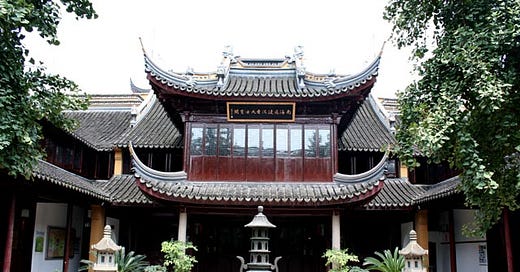Shoving off from my digs in Beilun, I at last moved from this trip's first base to its second and last, a hotel in the Jing'an district of Shanghai, where I visited one of the most precious little temples I saw in all of China, the "Incense Pavilion." Join me in this episode of
TEMPLE TALES!
I spent the entire day after my visit to Qita Temple, in Ningbo, in transit. I took a highway bus from Beilun to Shanghai South Bus Station, and (being an "old hand" at using subways, from my experience in Shenzhen - heh heh), managed to get to a stop near my hotel by taking only two lines.
The hotel was strategically chosen to be walking distance from three of my five "target" temples. (In fact, the district and the nearby subway stop are named for one of them, Jing'an Temple, which we'll visit in a few weeks.) That evening I took a pricey taxi to a pricey restaurant popular with expats, Malone's American Cafe, for the first and only night-on-the-town splurge of the entire trip. Nevertheless, I was in bed by nine! Big night.
Up the next morning, I stuck to what would become a fairly stable regimen of seeing the far-out first, and the nearby next. This led me to take a train and a bus down to the area of the City God Temple near Yuyuan Gardens, an area that looks more like an American Chinatown than an actual town in China!
An easy walk down a small side street took me to the day's first temple.
The Chenxiang Ge
The mostly-wooden Chenxiang Ge, Shanghai's "Incense Pavilion"
Called in Chinese Chenxiang Ge, both parts of the temple's name require some explanation. Let's take the last part first.
As I mentioned in Episode 056, most temples in China are named si (寺); the same character is pronounced ji in Japan, where it's also the most-used designation for temples. A number of other temples in China use yuan (院; Japanese in), meaning "compound" or "enclosure."
But these are not the only options. In some cases, the last element of a temple's name may be a specific building or other feature in the temple, and that is the case here. A ge (阁) is a pavilion, usually of two stories, and this one is named for a pretty little pavilion at the back of the compound.





